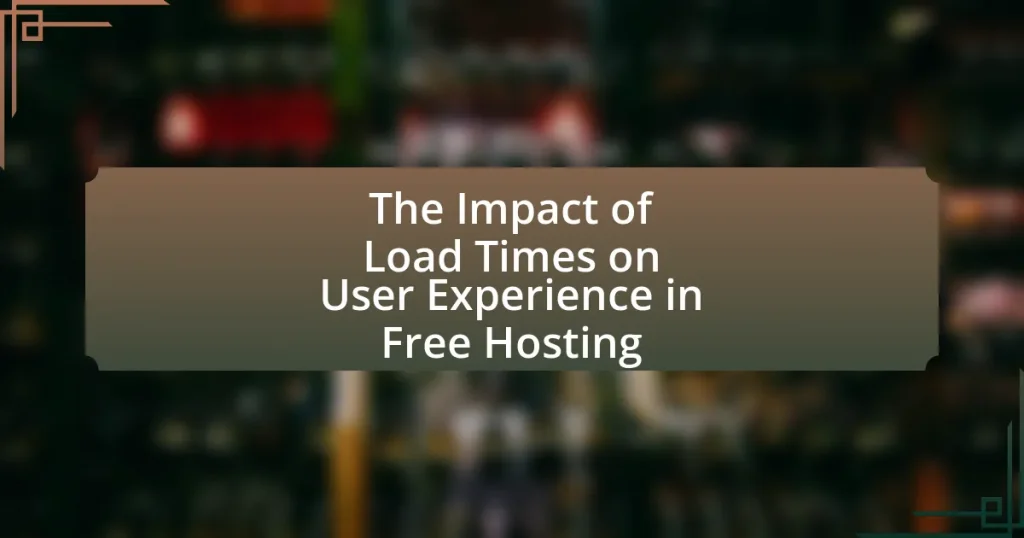The article examines the impact of load times on user experience in free hosting environments, emphasizing how slow load times can lead to higher bounce rates and decreased user satisfaction. It highlights that a one-second delay in page load time can result in a 7% reduction in conversions, with significant implications for user engagement and retention. The discussion includes the psychological effects of slow load times, common causes in free hosting, and optimization techniques to improve performance. Additionally, it addresses the correlation between load times and SEO rankings, brand perception, and overall digital marketing strategies.

What is the Impact of Load Times on User Experience in Free Hosting?
Load times significantly affect user experience in free hosting environments, often leading to higher bounce rates and lower user satisfaction. Research indicates that a one-second delay in page load time can result in a 7% reduction in conversions, highlighting the critical nature of speed in retaining users. Additionally, Google reports that 53% of mobile users abandon sites that take longer than three seconds to load. In free hosting, slower load times are common due to limited server resources, which can exacerbate these issues, ultimately diminishing user engagement and trust in the website.
How do load times affect user engagement on free hosting platforms?
Load times significantly affect user engagement on free hosting platforms by directly influencing users’ willingness to stay and interact with the content. Research indicates that a one-second delay in page load time can lead to a 7% reduction in conversions, highlighting the critical nature of speed in retaining users. Additionally, studies show that 40% of users abandon a website that takes more than three seconds to load, which is particularly relevant for free hosting platforms that often struggle with performance. Therefore, slower load times can result in higher bounce rates and lower overall user satisfaction, ultimately diminishing engagement levels.
What are the psychological effects of slow load times on users?
Slow load times negatively impact users’ psychological states by increasing frustration and anxiety. Research indicates that users often experience heightened stress levels when faced with delays, leading to a decrease in overall satisfaction and trust in the website. A study by Google found that 53% of mobile users abandon sites that take longer than three seconds to load, illustrating the direct correlation between load times and user abandonment rates. Furthermore, slow load times can create a perception of unprofessionalism, which can diminish users’ willingness to engage with the content or services offered. This psychological response is rooted in the expectation for immediate gratification in the digital age, where efficiency is highly valued.
How do load times influence user retention rates?
Load times significantly influence user retention rates, as faster loading websites lead to higher user satisfaction and engagement. Research indicates that a one-second delay in page load time can result in a 7% reduction in conversions, highlighting the direct correlation between speed and user retention. Additionally, a study by Google found that 53% of mobile users abandon sites that take longer than three seconds to load, demonstrating that slow load times can lead to increased bounce rates and decreased likelihood of return visits. Therefore, optimizing load times is crucial for maintaining user interest and loyalty in free hosting environments.
Why are load times critical for websites hosted on free platforms?
Load times are critical for websites hosted on free platforms because they directly affect user experience and engagement. Research indicates that a one-second delay in page load time can lead to a 7% reduction in conversions, as users are less likely to stay on a site that loads slowly. Additionally, free hosting services often have limited resources, which can exacerbate load times, leading to higher bounce rates. According to Google, 53% of mobile users abandon sites that take longer than three seconds to load, highlighting the importance of speed in retaining visitors. Therefore, optimizing load times is essential for maintaining user interest and achieving desired outcomes on free hosting platforms.
What are the common causes of slow load times in free hosting?
Common causes of slow load times in free hosting include limited server resources, high traffic on shared servers, and lack of optimization. Free hosting services often allocate minimal CPU and RAM, which can lead to slower processing times when multiple users access the server simultaneously. Additionally, since free hosting typically involves shared resources, heavy traffic from other websites can further degrade performance. Furthermore, many free hosting providers do not offer advanced optimization features, such as content delivery networks (CDNs) or caching, which are essential for improving load times. These factors collectively contribute to a subpar user experience, as studies show that a delay of just a few seconds can significantly increase bounce rates and decrease user satisfaction.
How do server resources impact load times in free hosting environments?
Server resources significantly impact load times in free hosting environments by limiting the available CPU, RAM, and bandwidth. In free hosting, providers often allocate minimal resources to each user, resulting in slower processing speeds and increased latency. For instance, a study by Google found that a one-second delay in load time can lead to a 20% decrease in user satisfaction and a 7% reduction in conversions. This correlation highlights how inadequate server resources can directly affect user experience, making websites less responsive and potentially driving users away.
What metrics are used to measure load times in free hosting?
The primary metrics used to measure load times in free hosting include Time to First Byte (TTFB), Fully Loaded Time, and First Contentful Paint (FCP). TTFB measures the time taken for the server to respond to a request, indicating server performance. Fully Loaded Time tracks the total time taken for all page resources to load, reflecting the overall user experience. FCP measures the time it takes for the first piece of content to appear on the screen, which is crucial for perceived performance. These metrics are essential for understanding how free hosting impacts user experience, as they directly correlate with user satisfaction and engagement.
What is the significance of Time to First Byte (TTFB) in user experience?
Time to First Byte (TTFB) is significant in user experience as it measures the responsiveness of a web server and the time it takes for a user’s browser to receive the first byte of data after a request. A lower TTFB indicates a faster server response, which enhances user satisfaction and engagement. Research shows that a TTFB of under 200 milliseconds is optimal for maintaining user interest, while delays exceeding 500 milliseconds can lead to increased bounce rates and decreased user retention. Therefore, optimizing TTFB is crucial for improving overall user experience, particularly in free hosting environments where server performance may vary.
How does page load speed correlate with user satisfaction?
Page load speed directly correlates with user satisfaction, as faster loading times lead to a more positive user experience. Research indicates that a one-second delay in page load time can result in a 7% reduction in conversions, highlighting the importance of speed in retaining user interest. Additionally, a study by Google found that 53% of mobile users abandon sites that take longer than three seconds to load, demonstrating that slow load times significantly impact user satisfaction and engagement.
How can slow load times be mitigated in free hosting?
Slow load times in free hosting can be mitigated by optimizing website assets, such as compressing images and minifying CSS and JavaScript files. These optimizations reduce the amount of data that needs to be transferred, leading to faster loading speeds. For instance, using tools like TinyPNG for image compression can decrease file sizes significantly without sacrificing quality, while minification tools like UglifyJS can streamline code. Additionally, leveraging browser caching allows frequently accessed resources to be stored locally on users’ devices, which decreases load times on subsequent visits. According to Google, optimizing these elements can improve load times by up to 50%, enhancing overall user experience.
What optimization techniques can improve load times on free hosting?
To improve load times on free hosting, techniques such as image optimization, minification of CSS and JavaScript, and leveraging browser caching can be employed. Image optimization reduces file sizes without sacrificing quality, which can significantly decrease loading times; for instance, using formats like WebP can reduce image sizes by up to 30% compared to JPEG. Minification of CSS and JavaScript removes unnecessary characters and spaces, leading to smaller file sizes and faster downloads. Leveraging browser caching allows frequently accessed resources to be stored locally on a user’s device, reducing the need for repeated downloads and improving load times. These techniques collectively enhance user experience by ensuring faster access to content on free hosting platforms.
How can users choose the right free hosting service to minimize load times?
Users can choose the right free hosting service to minimize load times by selecting providers that offer Content Delivery Networks (CDNs) and optimized server locations. CDNs distribute content across multiple servers globally, reducing the distance data must travel to reach users, which significantly decreases load times. Additionally, users should look for hosting services that provide solid uptime guarantees and fast server response times, as these factors directly influence how quickly a website loads. Research indicates that a one-second delay in load time can lead to a 7% reduction in conversions, highlighting the importance of fast hosting solutions.
What are the long-term effects of load times on brand perception in free hosting?
Long-term effects of load times on brand perception in free hosting include diminished trust and reduced customer loyalty. Research indicates that websites with slow load times can lead to a 7% reduction in conversions for every second of delay, which negatively impacts users’ perception of the brand’s reliability and professionalism. Additionally, a study by Google found that 53% of mobile users abandon sites that take longer than three seconds to load, suggesting that prolonged load times can result in a significant loss of potential customers and a tarnished brand image over time.
How do load times influence SEO rankings for websites on free hosting?
Load times significantly influence SEO rankings for websites on free hosting, as search engines prioritize user experience. Websites that load slowly can lead to higher bounce rates, which negatively impacts rankings. According to Google, page speed is a ranking factor; sites that load in under three seconds have a better chance of ranking higher in search results. Additionally, research by Akamai indicates that a one-second delay in load time can decrease customer satisfaction by 16% and reduce conversions by 7%. Therefore, optimizing load times is crucial for improving SEO performance, especially for websites on free hosting, where resources may be limited.
What role do load times play in the overall digital marketing strategy?
Load times are critical in digital marketing strategy as they directly influence user experience, conversion rates, and search engine rankings. Research indicates that a one-second delay in page load time can lead to a 7% reduction in conversions, highlighting the importance of speed in retaining potential customers. Additionally, Google has confirmed that site speed is a ranking factor in its algorithm, meaning slower load times can negatively impact visibility in search results. Therefore, optimizing load times is essential for enhancing user satisfaction and achieving marketing objectives.
What best practices can enhance user experience regarding load times in free hosting?
To enhance user experience regarding load times in free hosting, optimizing images is essential. Large image files significantly slow down page loading, so using compressed formats like JPEG or PNG and implementing responsive images can reduce load times. According to Google, optimizing images can improve loading speed by up to 80%, which directly correlates with better user retention and satisfaction. Additionally, leveraging browser caching allows frequently accessed resources to be stored locally, reducing load times for returning visitors. Research indicates that websites utilizing caching can load up to 50% faster for repeat users, enhancing overall user experience.
